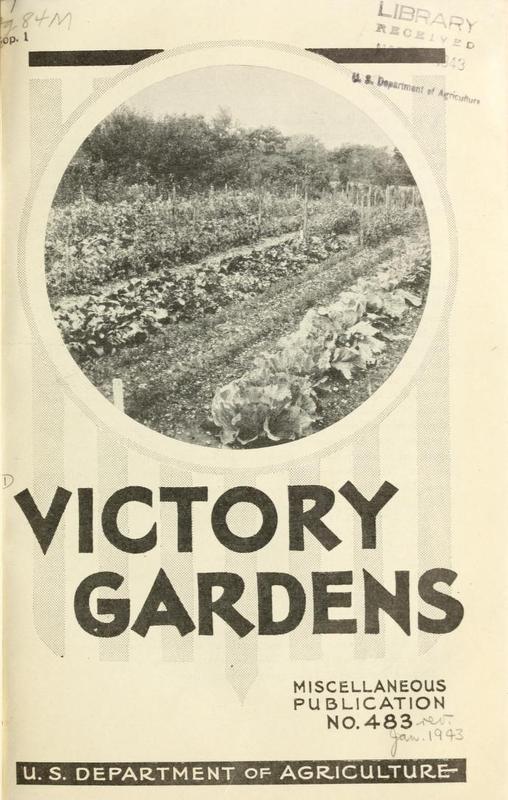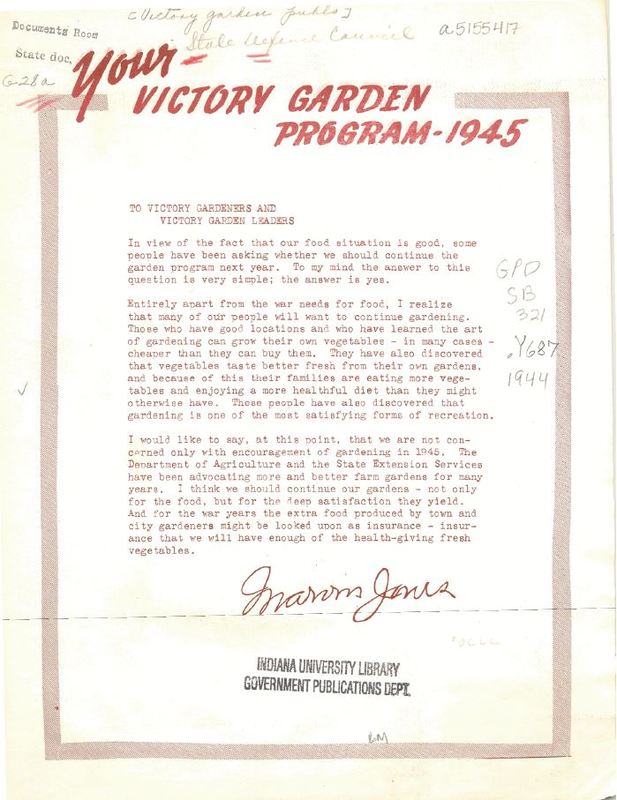Victory Garden Aids
The following reports published by the U.S. Department of Agriculture describe various methods for creating and maintaining the Victory Garden.
Victory Gardens (1943).
U.S. Department of Agriculture. Miscellaneous Publication: Number 483.
"IN TIMES OF WAR the country’s food supply for civilians may be smaller even though total production is greatly increased. The burdens of World War II are already creating serious food-production, distribution, and preservation problems. Labor and machinery shortages interfere with production; overloaded railroads and restricted motor transport interfere with distribution; and inadequate supplies of labor, steel, and tin demand that civilians depend less on foods canned in tin.
There is now real need for civilians to relieve the burden on commercial food sources, transportation, and preservation by growing all food that is practical at home and preserving, storing, and using it over as much of the year as possible.
More than $200,000,000 worth of vegetables — not counting potatoes and sweet potatoes — were grown in farm home gardens in 1939. These 4,800,000 home gardens produced vegetables worth a little more than those grown for sale on 3,000,000 acres. Thus, it is obvious that home-grown vegetables can and do furnish a substantial part of our national requirements. If all farmers grow better gardens and all favorably located town dwellers also do their best, a still greater share of the civilian requirements can be met. Now all civilians need to help themselves by home food production insofar as practicable so that more of the country's commercial resources can be devoted to military and lend-lease food requirements."
Victory Garden Leader's Handbook (1943).
Boswell, Victor Rickman. U.S. Department of Agriculture.
"This handbook offers some suggestions to those 'who are leading the great drive for Victory Gardens,' and points out certain things to watch out for - common errors which waste seed, fertilizer, land, and labor, and therefore must be most carefully avoided in wartime....
About 18 million families this year will…grow…Victory Gardens. Many of these people will be growing a garden for the first time - and they need help.
Every farm where weather and water supplies permit can produce the family's entire year's supply of vegetables, both fresh and processed, and also as much fruit as possible.
In town and suburban back yards: Families who have sufficient open sunny space and fertile ground can grow a large supply of vegetables for their own use.
In community gardens: People living in metropolitan areas seldom have enough suitable ground at home for a garden, but supervised community projects with space allotted to each garden have proven successful. Preferably they should be within walking distance or a short bus or street car ride. In some towns and cities, groups have arranged with a nearby farmer for the use of an acre or so of good land to use as a community garden, paying in either crops or cash. As part of the bargain, the farmer plows and drags the soil.
In school gardens: Rural and city schools can have gardens planned and managed on a scale that will provide a large part of the fresh and processed vegetables for school lunches."
Victory Garden Kit: Your Victory Garden Program (1945).
U.S. Department of Agriculture.
"I would like to say, at this point, that we are not concerned only with encouragement of gardening in 1945. The Department of Agriculture and the State Extension Services have been advocating more and better farm gardens for many years. I think we should continue our gardens - not only for the food, but for the deep satisfaction they yield. And for the war years the extra food produced by town and city gardeners might be looked upon as insurance - insurance that we will have enough of the health-giving fresh vegetables."
Victory Garden Insect Guide (1944).
U.S. Department of Agriculture.
"Now, in time of war, the need for maximum production of food is more important than ever before. Our Government is asking urban as well as rural people to contribute their share again this year in meeting our huge food requirements. They can do this by growing Victory Gardens to supply their home needs for vegetables, thus releasing food produced from other sources to feed our fighters, our allies, and our workers on the home front.
Twenty-two million Victory Gardens is the goal set for 1944. This means that we need about 16 million city, town, and suburban gardens.
Insects that feed on garden crops must be controlled. In this guide the gardener will find a general discussion of insects and their control. Insects having the same or similar habits are listed together, and methods for combating them are given. No attempt is made to discuss each insect separately, or to give as wide a variety of control measures as commercial growers would need. A knowledge of insects and their food habits will be useful in applying control measures and will also lessen the sometimes groundless fear of damage they may cause. For example, many insects that will not cause crop damage will be found in the garden, their presence being merely incidental."
A Victory Gardener's Handbook on Insects and Diseases (1944).
White, William Henry and Doolittle, Sears Polydore. U.S. Department of Agriculture
Miscellaneous Publication: Number 525.
"THIS PUBLICATION has been prepared to aid the gardener in identifying the more common insects and related forms and the more common diseases that attack vegetable gardens in the United States and to provide him with simple directions for the control of these pests.
In the space available in this publication it is impossible to give detailed recommendations for the control of the insects and diseases listed or to include information on additional insects and diseases which may be found locally in vegetable gardens in various parts of the country. An attempt has been made, moreover, to simplify the directions for the preparation and application of the insecticides and fungicides recommended. For this reason the sprays dusts, solutions, and baits have been reduced to a minimum and made as uniform as possible, even though in some instances the directions given herein for the preparation of the small quantities of materials usually needed for vegetable gardens may not conform exactly to the directions in the more detailed publications of the Department.
It has been necessary to adjust or change some of the recommendations appearing in previous publications, owing to the necessity of conserving certain materials, such as rotenone and pyrethrum, which have been made scarce bv war conditions or whose use is limited by orders of the War Production Board to application on specified crops against certain species of insects."
Victory Gardeners Can Prevent Ear-Worms From Entering Their Corn (1943).
U.S. Department of Agriculture
AWI: Number 58.
"The corn earworm is the principal insect enemy of sweet corn. The larvae (or worms), hatching from eggs usually laid on the silks, feed in the interior silk mass and burrow toward the kernels, which they also devour if not prevented.
For controlling the earworm, use an inexpensive white mineral oil (medicinal oil) or, if you can buy it already mixed, a refined mineral oil containing 0.2 percent of pyrethrins. The latter is more effective. One pint will treat about 600 ears. If properly used, the insecticide will not injure the ears, leaves no flavor on the kernels, in no way damages the corn for food, and will completely protect 75 to 90 percent of all ears.
Use an ordinary glass medicine dropper that holds about 20 drops when half full. This amount is enough for a small ear. For a large ear, fill the dropper about three-fourths full. Larger amounts may reach the kernels and cause injury. Insert the medicine dropper about a quarter of an inch into the silk mass, just inside the tip of the husk. The oil quickly penetrates the silk mass, kills worms feeding there, and prevents the entry of others.
Since not all of the silks mature at the same time, it may be necessary to make more than one trip through the corn patch. Treated ears may be marked with a crayon or strip of cloth.
Wait at least 3 days after the silk first emerges from the tip of the ear before applying the oil. By that time the silks should be wilted and the tips beginning to turn brown. If applied too soon, the oil interferes with pollination, but if application is delayed more than 7 days after silking, the ear worms may start feeding on the kernels and cannot be reached with the oil. The Victory gardener who treats his corn for earworms as directed, particularly if the earworm is abundant, will be well repaid by a harvest of perfect ears."
 An official website of the United States government.
An official website of the United States government.







